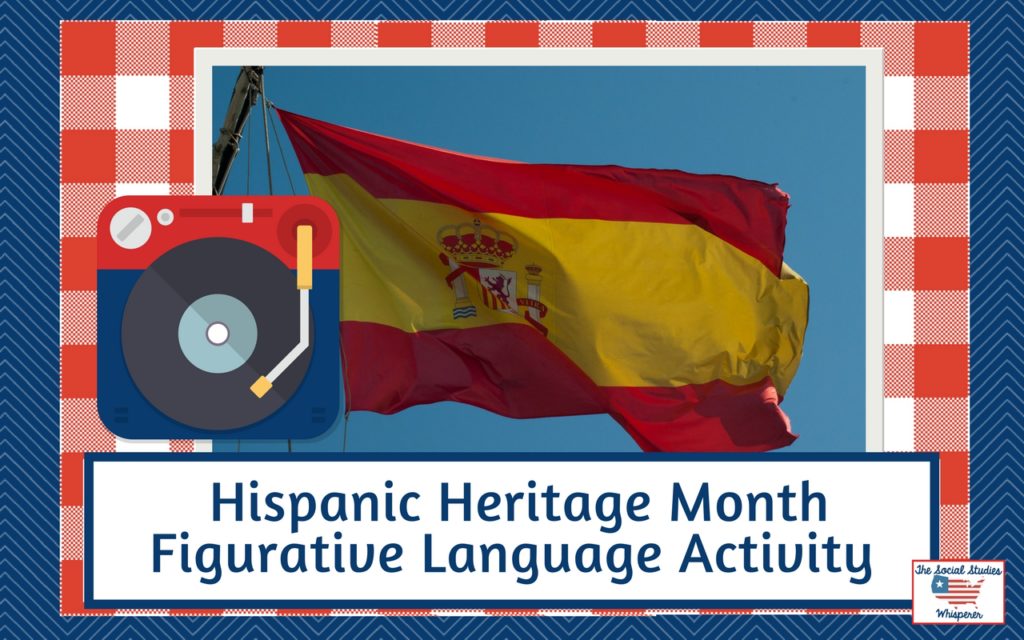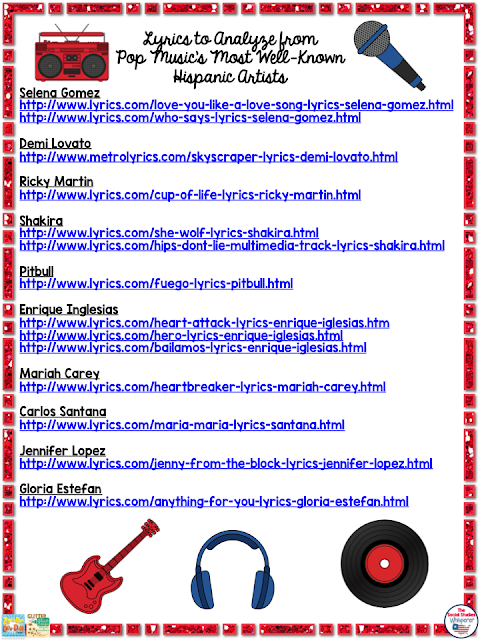
As a creative brain, I am always striving to make connections so I love word play! Bonus points if you spot all my cheesy examples within the post. Analogies, Metaphors, and puns-oh my! Figurative language is the spice of writing. I am a huge proponent of integrating literacy and music into everythhinnngggg because I love those as much as I do Social Studies! I also have been an avid user and super fan of Flocabulary for over 4 years! I’ve got the perfect way to combine all of these things into a Hispanic Heritage Month activity (and spoiler-this lesson could be done any time of year). It’s gonna be the cat’s meow!
If you are not in the “Flo know”, let me fill you in. Flocabulary is an educational website featuring super-catchy hip-hop clips….and much more! At first I just showed the videos like I would have a YouTube clip. Well, over the years I have had a subscription things have snowballed into a grander vision. The site now includes companions for each of their 750 cross-curricular clips including: printable lyrics, assessments, quizzes, graphic organizers, background info for teachers, lesson plans, and the recently released Read and Respond and Lyric Lab features. Please note it is a paid site but they offer generous free trials!
Ok, let’s get to the nitty gritty. This activity could be completed in a variety of ways depending on the background knowledge of your learners. Please take the idea and make it your own! It is best for students who already have experience with figurative language. I helped refresh my students’ memory and hook their attention by first showing the general Figurative Language Clip.
During the clip, I had students make a list of the different types of literary devices that were mentioned in their Readers’ Notebook (or you could do a post-it note). Then afterwards I had them quickly compare what they wrote with a partner (this way your super shy kids are participating because they aren’t gonna raise their hand). Then I asked for volunteers to share what they wrote down and an example if possible with the whole class and I made an anchor chart to hang up in the room!
The next thing I did was give kids a copy of the lyrics to glue in their Readers’ Notebook. You could go back and have kids annotate the lyrics or highlight the key vocabulary. When you pull up the interactive lyrics on the site, the main ideas are featured in blue so that makes it easy for kids to know what’s important!
If your kiddos need more practice with specific types of figurative language you could rinse and repeat the same process with the Analogies, Idioms, and Similes/Metaphors Flocabulary clips. You can find them all here: More Figurative Language. I often used the lyrics for a close reading passage. I remember also having kids find and highlight all of the idioms in the lyrics for that clip as a quick assessment! Piece of cake to grade!
Speaking of lyrics, let’s expand the idea into using song lyrics from Hispanic musical artists! Give your kids printed lyrics and have them find examples of figurative language! I’m warning you to be ready because you are going to light a spark, especially with your gifted learners. They won’t be able to listen to a song ever again without finding examples so capitalize on it! I had a stack of sentence strips sitting in my classroom for kids to write examples on (and I let them use my markers to do it, WHOA) they had found while at a home and turned it into a build-a-bulletin board by just taping them on the classroom door. You could also do this on a tri-fold display board.
The scope of your study on Hispanic Heritage may vary greatly from what I did so just make sure to frame the lesson into context first to explain why you chose these artists. When I said we were doing this as part of Hispanic Heritage Month, it wasn’t the first kids had heard of it. It could be though! Do you! But I promise you when you tie in pop culture to your content, your kids will geek out. And think of you as the bees’ knees because you know modern songs.
Now make sure you plan ahead, especially if you are using bilingual lyrics, to make sure everything is on the up and up. As in appropriate for kids. You could have kids brainstorm a list of artists. I had a predominantly Hispanic population of students so they loved doing this (build that community baby!!). And the ESOL-certified side of me has to give a disclaimer to remember that your newcomers may struggle with idioms because they don’t translate across cultures figuratively. Um, on a hot dog package the Spanish version will say “chicken sausage” not “perro caliente.” What can your ELLs do for this then? Find examples of onomatopoeia or alliteration!
So I bet you are thinking, “Where in the world can I find song lyrics?” I got you covered!
- http://www.lyrics.com BOOM!
- http://www.metrolyrics.com BOOM!
- https://www.google.com/ POW! C’mon people!
Maybe you are thinking, I sure wish I could find a list of good songs that would work. I’m your BFF right now. Right click to save the picture or contact me on my contact page and I’ll send you the PDF!
Want to know more about how I have used Flocabulary? I have several more posts for you to check out listed below!

